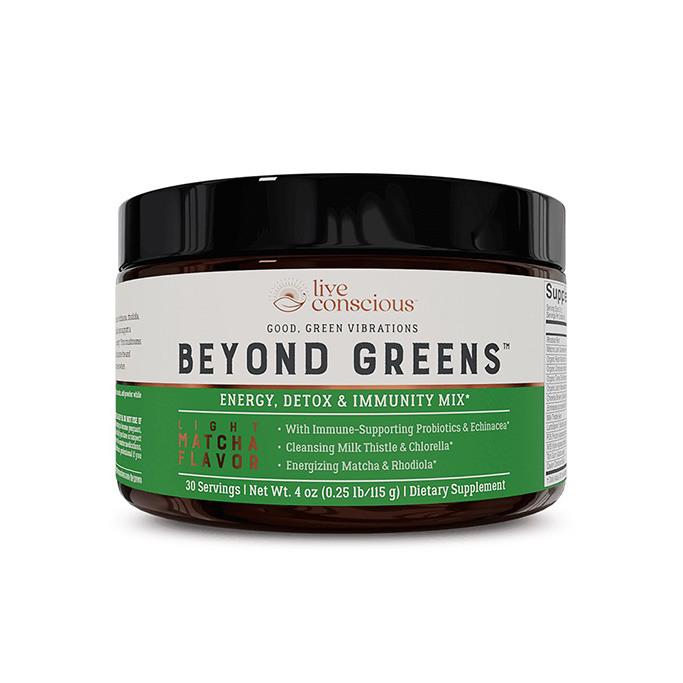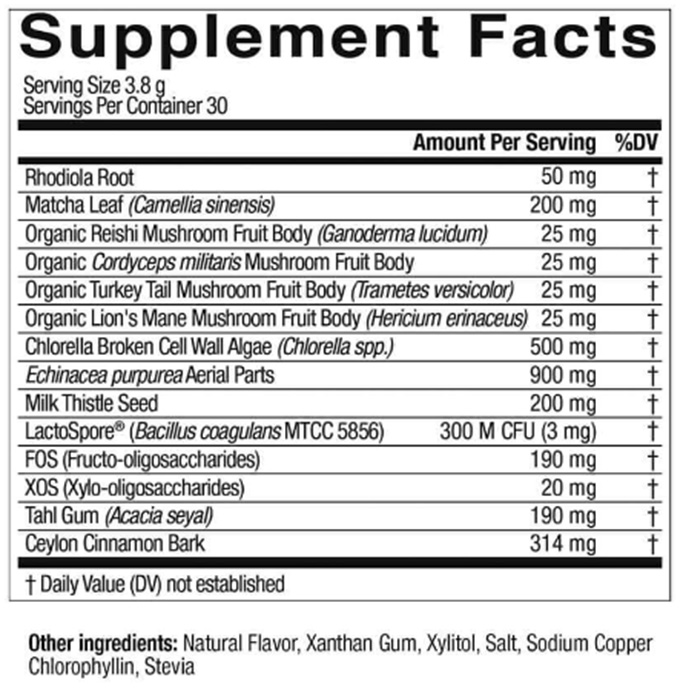Table of Contents
About Beyond Greens

Beyond Greens is a product by the company LiveWell. It is an all-in-one superfood multivitamin mix containing prebiotics, probiotics, herbs, and mushrooms. Vegan, gluten-free, keto-friendly, non-GMO, soy-free, it is an easy way to achieve good gut health, immunity, and energy.
Beyond Greens Superfood Ingredients

Milk Thistle
Milk thistle is a flowering herb that belongs to the daisy and ragweed family. It is commonly used as a natural remedy to support liver function and promote overall health.
The active ingredient in milk thistle is called silymarin, which is a mixture of flavonoids, including silybin, silydianin, and silychristin. Silymarin is known for its potent antioxidant and anti-inflammatory properties, which help protect liver cells from damage caused by free radicals and toxins.
Some of the potential benefits of milk thistle include:
Supporting liver function: Milk thistle has been shown to support liver function and promote liver detoxification. It can help protect liver cells from damage and improve liver enzyme levels in people with liver disease.
Lowering cholesterol: Some studies have suggested that milk thistle may help lower LDL (bad) cholesterol levels and increase HDL (good) cholesterol levels, which can help reduce the risk of heart disease.
Reducing inflammation: Milk thistle has anti-inflammatory properties that may help reduce inflammation in the body, which is linked to a variety of chronic diseases.
Supporting skin health: Milk thistle may help improve skin health by reducing inflammation and oxidative stress, which can contribute to skin aging and damage.
Supporting brain health: Some research suggests that milk thistle may have neuroprotective properties and could potentially improve cognitive function and memory.
Rhodiola Rosea
Rhodiola Rosea is a plant that grows in cold regions of the world, including the Arctic and mountainous regions of Asia and Europe. It has been used for centuries in traditional medicine in those areas. The root of the Rhodiola Rosea plant is used to make supplements, extracts, and teas.
Rhodiola Rosea is an adaptogenic herb, which means it helps the body adapt to stress and anxiety. It is also believed to improve mood, cognitive function, and physical endurance.
Research suggests that Rhodiola Rosea may help reduce fatigue, depression, and anxiety in people with mild to moderate symptoms. It may also help improve exercise performance and reduce symptoms of altitude sickness.
Rhodiola Rosea contains a number of active compounds, including salidroside and rosavin, which are thought to be responsible for its therapeutic effects. It is generally considered safe when taken in recommended doses, although it may interact with certain medications.
Echinacea
Echinacea is a flowering plant in the daisy family that is native to North America. The root, flowers, and leaves of Echinacea are used in herbal medicine. Echinacea is believed to have several health benefits, including:
Immune system support: Echinacea is commonly used to boost the immune system, and studies have suggested that it may be effective in reducing the incidence and duration of colds and flu.
Anti-inflammatory properties: Echinacea has been found to have anti-inflammatory properties, which may be useful in treating conditions such as arthritis and inflammatory skin conditions.
Antioxidant effects: Echinacea contains compounds such as flavonoids and caffeic acid derivatives that have antioxidant properties, which may help protect cells from damage caused by free radicals.
Pain relief: Echinacea has been found to have analgesic effects and may be useful in reducing pain, particularly in conditions such as toothache and sore throat.[13]
Matcha
Matcha is a type of green tea that is ground into a fine powder. It is made from shade-grown tea leaves, which are hand-picked, steamed, and dried before being ground into a powder. Matcha has been used for centuries in Japanese tea ceremonies and is known for its vibrant green color, unique flavor, and numerous health benefits.
One of the main benefits of matcha is its high concentration of antioxidants, particularly catechins.
Catechins are a type of flavonoid that have been shown to have anti-inflammatory and anti-cancer properties. Matcha also contains caffeine and L-theanine, an amino acid that can promote relaxation and reduce stress.
Other potential health benefits of matcha include improving brain function, boosting metabolism, and reducing the risk of heart disease. It may also help to lower blood sugar levels and improve insulin sensitivity, making it potentially beneficial for people with type 2 diabetes.
It is worth noting that matcha does contain caffeine, so it should be consumed in moderation and may not be suitable for everyone. Additionally, the quality of matcha can vary greatly, so it is important to choose a high-quality, organic product to ensure maximum health benefits.
Chlorella
Chlorella is a type of freshwater green algae that is considered a superfood due to its high nutrient content. It is rich in chlorophyll, a pigment that gives plants their green color and has antioxidant properties that may help protect cells from damage caused by free radicals.
Chlorella is also a good source of protein, essential fatty acids, vitamins (including vitamin B12), and minerals (including iron, magnesium, and calcium).
Some of the potential health benefits associated with chlorella include improving immune function, reducing inflammation, and promoting detoxification. Some studies have suggested that chlorella may help to boost immune function by increasing the production of white blood cells and improving the activity of natural killer cells.
Other research has indicated that chlorella may help to reduce inflammation by inhibiting the production of pro-inflammatory cytokines. Additionally, chlorella may promote detoxification by binding to heavy metals and other toxins in the body, helping to remove them through the digestive tract.
While chlorella is generally considered safe for most people, some individuals may experience side effects such as gastrointestinal upset or allergic reactions. People who are pregnant or breastfeeding, or who have certain medical conditions, should consult with a healthcare provider before taking chlorella or any other dietary supplement.
Lactospore (Bacillus Coagulans)
Lactospore (Bacillus coagulans) is a probiotic bacterium that is commonly used as a dietary supplement. It is a spore-forming, lactic acid-producing bacterium that is naturally found in soil, water, and the digestive tracts of some animals, including humans.
The benefits of Lactospore include improving digestion and immune system function. It helps to promote a healthy balance of gut bacteria, which can help to prevent and treat digestive issues such as bloating, gas, and diarrhea It also supports the immune system by helping to reduce inflammation and increase the production of antibodies.
Lactospore has been shown to be safe and well-tolerated in clinical studies, and it does not require refrigeration, which makes it a convenient probiotic option for many people. It can be found in various dietary supplements, including probiotic blends, digestive enzyme supplements, and immune support formulas.
FOS & XOS (Fructo- and Xylo-Oligosaccharides)
Fructo- and Xylo-oligosaccharides (FOS and XOS, respectively) are types of prebiotic dietary fibers. Prebiotics are indigestible fibers that are fermented by beneficial bacteria in the gut, helping to promote the growth of a healthy gut microbiome.
FOS are naturally found in many fruits and vegetables, such as bananas, onions, garlic, and asparagus, while XOS are typically sourced from plant-based materials, such as sugarcane pulp or hardwood. Both FOS and XOS are low in calories and have a slightly sweet taste.
The main benefits of FOS and XOS are their ability to promote digestive health and support the growth of beneficial gut bacteria, such as Bifidobacteria and Lactobacilli.
They have also been shown to have a prebiotic effect, which means they can enhance the absorption of important nutrients, such as calcium and magnesium.
Other potential benefits of FOS and XOS include improved immune function, reduced inflammation, and better blood sugar regulation. Additionally, these fibers can help to promote feelings of fullness and aid in weight management.
It’s worth noting that while FOS and XOS are generally safe and well-tolerated, some people may experience digestive discomfort, such as bloating and gas, when consuming high amounts. It’s recommended to start with a small amount and gradually increase intake to avoid any discomfort.
Acacia Gum
Acacia gum, also known as gum arabic, is a natural plant-derived product that is commonly used as a food additive. It is extracted from the sap of various species of acacia trees, which are native to Africa, but also grown in other parts of the world.
Acacia gum has several beneficial properties, including its ability to act as a prebiotic, which means it can support the growth of beneficial gut bacteria. It also has emulsifying properties, which makes it useful in the food industry as a stabilizer and thickening agent.
Acacia gum is also low in calories and can help with weight management, as it can increase feelings of fullness and reduce the absorption of fat.
In addition, acacia gum has been shown to have anti-inflammatory properties and may have a positive effect on blood sugar levels, making it potentially beneficial for people with diabetes. It may also have potential as a natural remedy for digestive issues, such as diarrhea and irritable bowel syndrome (IBS).
It is worth noting that some people may be allergic to acacia gum, so it is important to be aware of any potential adverse reactions.
Ceylon Cinnamon
Ceylon cinnamon, also known as “true” cinnamon, is a type of cinnamon that is native to Sri Lanka and southern India. It is made from the inner bark of the Cinnamomum verum tree and is considered to be higher quality than the more commonly used Cassia cinnamon.
Ceylon cinnamon has several potential health benefits, including anti-inflammatory and antioxidant properties, which may help reduce inflammation and prevent cellular damage caused by free radicals. It may also help regulate blood sugar levels and improve insulin sensitivity, which can be beneficial for people with diabetes.
In addition, it may have antibacterial and antifungal properties and could potentially improve brain function and lower the risk of neurodegenerative diseases.
It is important to note that cinnamon, including Ceylon cinnamon, should be consumed in moderation and as part of a healthy and balanced diet. Large amounts of cinnamon may have negative effects on the liver, and some people may be allergic to it.
References
1. Choe, U., et al., The chemical composition of a cold-pressed milk thistle seed flour extract, and its potential health beneficial properties. Food & Function, 2019. 10(5): p. 2461-2470. https://pubs.rsc.org/en/content/articlelanding/2019/fo/c9fo00377k/unauth
2. Aghemo, A., et al., Role of silymarin as antioxidant in clinical management of chronic liver diseases: A narrative review. Annals of Medicine, 2022. 54(1): p. 1548-1560. https://www.tandfonline.com/doi/full/10.1080/07853890.2022.2069854
3. Gillessen, A. and H.H.-J. Schmidt, Silymarin as supportive treatment in liver diseases: A narrative review. Advances in Therapy, 2020. 37(4): p. 1279-1301. https://link.springer.com/article/10.1007/s12325-020-01251-y
4. Kazazis, C.E., et al., The therapeutic potential of milk thistle in diabetes. The Review of Diabetic Studies: RDS, 2014. 11(2): p. 167. https://www.ncbi.nlm.nih.gov/pmc/articles/PMC4310066/
5. Liu, W., et al., Potent inhibitory effect of silibinin from milk thistle on skin inflammation stimuli by 12-O-tetradecanoylphorbol-13-acetate. Food & Function, 2015. 6(12): p. 3712-3719. https://pubs.rsc.org/en/content/articlelanding/2015/fo/c5fo00899a/unauth
6. Shahrajabian, M.H., W. Cheng, and Q. Cheng, Milk thistle, myrrh and mint: Herbal plants as natural medicines. Nutrition and Food Sciences Research, 2021. 8(3): p. 59-65. https://nfsr.sbmu.ac.ir/article-1-470-fa.html
7. Badreddine, A., et al., Antioxidant and neuroprotective properties of Mediterranean oils: Argan oil, olive oil, and milk thistle seed oil, in Oxidative stress and dietary antioxidants in neurological diseases. 2020, Elsevier. p. 143-154. https://www.sciencedirect.com/science/article/pii/B9780128177808000104
8. Concerto, C., et al., Exploring the effect of adaptogenic Rhodiola Rosea extract on neuroplasticity in humans. Complementary Therapies in Medicine, 2018. 41: p. 141-146. https://www.sciencedirect.com/science/article/abs/pii/S0965229918307465
9. Parsons, J.L., et al., Echinacea biotechnology: Advances, commercialization and future considerations. Pharmaceutical Biology, 2018. 56(1): p. 485-494. https://www.tandfonline.com/doi/full/10.1080/13880209.2018.1501583
10. Woelkart, K., et al., Bioavailability and pharmacokinetics of Echinacea purpurea preparations and their interaction with the immune system. International Journal of Clinical Pharmacology & Therapeutics, 2006. 44(9). https://pubmed.ncbi.nlm.nih.gov/16995328/
11. Sharma, S., et al., Bactericidal and anti-inflammatory properties of a standardized Echinacea extract (Echinaforce®): Dual actions against respiratory bacteria. Phytomedicine, 2010. 17(8-9): p. 563-568. https://www.sciencedirect.com/science/article/abs/pii/S094471130900292X
12. Mishima, S., et al., Antioxidant and immuno-enhancing effects of Echinacea purpurea. Biological and Pharmaceutical Bulletin, 2004. 27(7): p. 1004-1009. https://www.jstage.jst.go.jp/article/bpb/27/7/27_7_1004/_article/-char/ja/
13. Samuel, D.S. and S.P. Priyadarshoni, Echinacea purpurea-A potent medicinal herb. Drug Invention Today, 2019. 11(2). https://eds.p.ebscohost.com/eds/detail/detail?vid=0&sid=0d03f039-1798-4521-abe4-a36aa000033c%40redis&bdata=JnNpdGU9ZWRzLWxpdmUmc2NvcGU9c2l0ZQ%3d%3d
14. Kochman, J., et al., Health benefits and chemical composition of matcha green tea: A review. Molecules, 2020. 26(1): p. 85. https://www.mdpi.com/1420-3049/26/1/85
15. Jakubczyk, K., et al., Antioxidant properties and nutritional composition of matcha green tea. Foods, 2020. 9(4): p. 483. https://www.mdpi.com/2304-8158/9/4/483
16. Burcuș, A., et al. Antioxidant, anti-inflammatory, and antibacterial potential of different drinks based on Matcha tea. in IOP Conference Series: Materials Science and Engineering. 2018. IOP Publishing. https://iopscience.iop.org/article/10.1088/1757-899X/374/1/012072/meta
17. Yoto, A., et al., Effects of L-theanine or caffeine intake on changes in blood pressure under physical and psychological stresses. Journal of Physiological Anthropology, 2012. 31(1): p. 1-9. https://jphysiolanthropol.biomedcentral.com
18. Nagao, T., T. Hase, and I. Tokimitsu, A green tea extract high in catechins reduces body fat and cardiovascular risks in humans. Obesity, 2007. 15(6): p. 1473-1483. https://onlinelibrary.wiley.com/doi/full/10.1038/oby.2007.176
19. Bito, T., et al., Potential of Chlorella as a dietary supplement to promote human health. Nutrients, 2020. 12(9): p. 2524. https://www.mdpi.com/2072-6643/12/9/2524
20. Sibi, G., Inhibition of lipase and inflammatory mediators by Chlorella lipid extracts for antiacne treatment. Journal of Advanced Pharmaceutical Technology & Research, 2015. 6(1): p. 7. https://www.ncbi.nlm.nih.gov/pmc/articles/PMC4330611/
21. Lee, I., et al., Detoxification of chlorella supplement on heterocyclic amines in Korean young adults. Environmental Toxicology and Pharmacology, 2015. 39(1): p. 441-446. https://www.sciencedirect.com/science/article/pii/S1382668914002853
22. Jurenka, J.S., Bacillus coagulans. Alternative Medicine Review, 2012. 17(1): p. 76-82. https://go.gale.com/ps/i.do
23. Shinde, T., et al., Probiotic Bacillus coagulans MTCC 5856 spores exhibit excellent in-vitro functional efficacy in simulated gastric survival, mucosal adhesion and immunomodulation. Journal of Functional Foods, 2019. 52: p. 100-108. https://www.sciencedirect.com/science/article/abs/pii/S175646461830553X
24. Pham, V.T., et al., Antioxidant vitamins and prebiotic FOS and XOS differentially shift microbiota composition and function and improve intestinal epithelial barrier in vitro. Nutrients, 2021. 13(4): p. 1125. https://www.mdpi.com/1052628
25. Muir, J.G., et al., Fructan and free fructose content of common Australian vegetables and fruit. Journal of Agricultural and Food Chemistry, 2007. 55(16): p. 6619-6627. https://pubs.acs.org/doi/abs/10.1021/jf070623x
26. Moure, A., et al., Advances in the manufacture, purification and applications of xylo-oligosaccharides as food additives and nutraceuticals. Process Biochemistry, 2006. 41(9): p. 1913-1923. https://www.sciencedirect.com/science/article/abs/pii/S135951130600198X
27. Sanchez, C., et al., Acacia gum: History of the future. Food Hydrocolloids, 2018. 78: p. 140-160. https://www.sciencedirect.com/science/article/abs/pii/S0268005X17306112
28. Phillips, G.O., Acacia gum (Gum Arabic): A nutritional fibre; metabolism and calorific value. Food Additives & Contaminants, 1998. 15(3): p. 251-264. https://www.tandfonline.com/doi/abs/10.1080/02652039809374639
29. Cherbut, C., et al., Acacia gum is a bifidogenic dietary fibre with high digestive tolerance in healthy humans. Microbial Ecology in Health and Disease, 2003. 15(1): p. 43-50. https://www.tandfonline.com/doi/abs/10.1080/08910600310014377
30. Suriyagoda, L., et al., “Ceylon cinnamon”: Much more than just a spice. Plants, People, Planet, 2021. 3(4): p. 319-336. https://nph.onlinelibrary.wiley.com/doi/full/10.1002/ppp3.10192
31. Ranasinghe, P. and P. Galappaththy, Health benefits of Ceylon cinnamon (Cinnamomum zeylanicum): A summary of the current evidence. Ceylon Medical Journal, 2016. 61(1). https://www.fortifiedricebybrowns.com
32. Lungarini, S., F. Aureli, and E. Coni, Coumarin and cinnamaldehyde in cinnamon marketed in Italy: A natural chemical hazard? Food Additives and Contaminants, 2008. 25(11): p. 1297-1305. https://www.tandfonline.com/doi/abs/10.1080/02652030802105274
You might also be interested in reading about Plenity Ingredients or Relief Factor Ingredients.

Leave a Reply